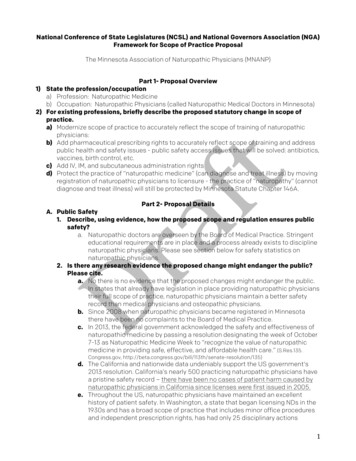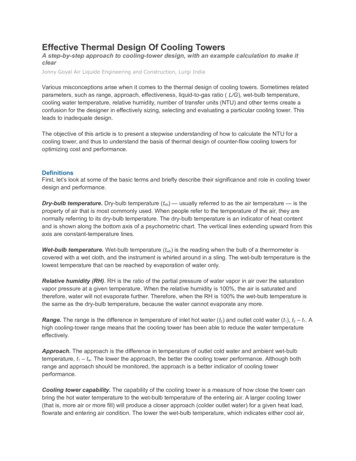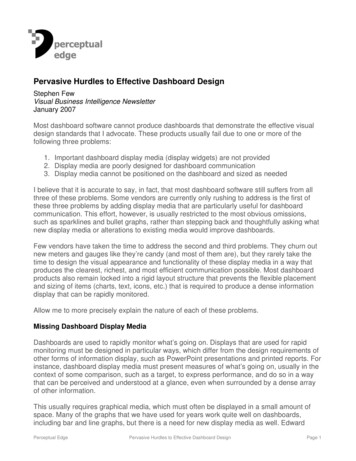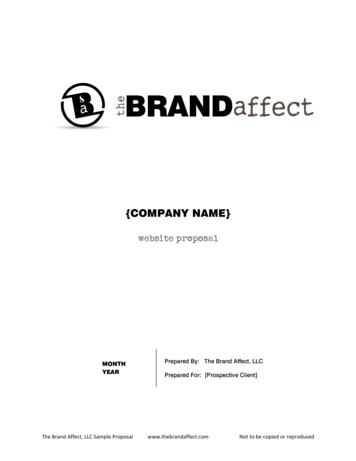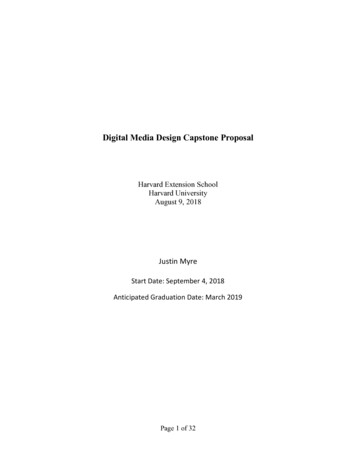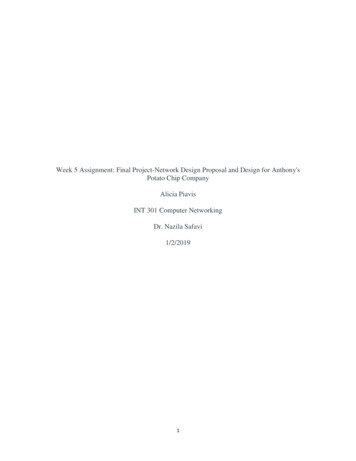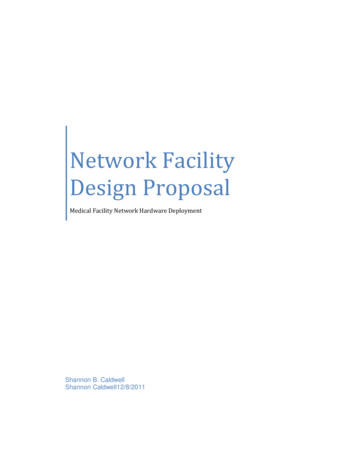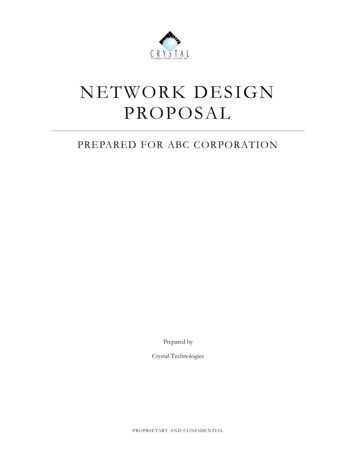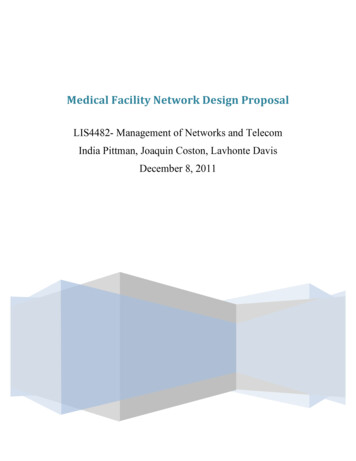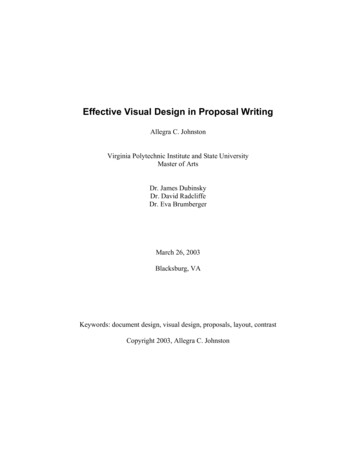
Transcription
Effective Visual Design in Proposal WritingAllegra C. JohnstonVirginia Polytechnic Institute and State UniversityMaster of ArtsDr. James DubinskyDr. David RadcliffeDr. Eva BrumbergerMarch 26, 2003Blacksburg, VAKeywords: document design, visual design, proposals, layout, contrastCopyright 2003, Allegra C. Johnston
Abstract: Effective Visual Design in Proposal WritingAllegra JohnstonThe field of document design has gained considerable attention over the past couple ofdecades. New technology has drastically increased the design possibilities for writers, andresearchers are gaining greater insight into the way that readers interact with the visual elementsof their texts. This has led to an explosion in the availability of guidance on document design,but there are still areas where the research is incomplete. One of these areas concerns a commonbut important type of document: the proposal. There are numerous guides on proposal writing,but most of them are concerned with content and give little attention to document design. Sincesuccessful proposals are crucial to both the business and non-profit arenas, it is important that thedocuments are accessible and make a good impression on reviewers. Good document design canhelp.In this study I took the existing research on document design and developed a set ofquestions meant to address the different elements of document design. I tested a sampling ofboth grant proposals and contract proposals using those questions with a system of scoring basedon Likert scaling. I combined the quantitative results with qualitative responses from interviewsin order to gain insight regarding the overall effect of visual design elements in proposals. Theresults of this study showed that there are certain elements of document design (such as layout orcontrast) that are important to proposals, but that non-design factors (such as cost or experience)usually outweigh the design for evaluation purpose.
Johnston iiiTable of ContentsAbstract . iList of Multimedia Objects . iiiChapter 1: Introduction . 3Chapter 2: What Makes a Good Proposal? Review of Current Literature.10Chapter 3: Project Details . 30Chapter 4: Results . 39Works Cited . 56 (Appendix A)Checklist Used for Pilot Test 60 (Appendix B)Proposal Evaluation Checklist (final version) .61 (Appendix C)RFP from The Community Foundation for the New River Valley .63 (Appendix D)Excerpts of RFP from Defense Logistics Agency 65 (Appendix E)Initial Interview Questions (Grants) .69 (Appendix F)Initial Interview Questions (Contracts) 72 (Appendix G)Calculations .75 (Appendix H)
Johnston ivList of Multimedia ObjectsChart 1: Example Information Graphic 20Figure 1: Gestalt example . 12Figure 2: Contrast/Rhetoric example 14Figures 3 and 4: Contrast examples . 17Figure 5: Logo example 19Figure 6: Text box example . 19Figures 7 and 8: Use of Contrast in Grant Proposals .45Figure 9: Color/Logo in Grant Proposal . 46Table 1: Numerical Results (All Design Categories Combined) .40Table2: Individual Category Scores for Contract Proposals 43
Johnston 1Chapter 1: IntroductionDesktop publishing is changing the nature of practical communication because it placesvisual design at the heart of the composing process, giving us unprecedented power toarticulate the text with typefaces, graphic cues, and spatial variations. These designelements, however, do not transmit the text passively: they are rhetorically active becausethey affect the reader’s reception of the message.-- Charles KostelnickI first began to understand that importance of document design while working in agovernment contracting office. Each year we would solicit and receive proposals for variousgoods and services, and while I found that submitting an average-looking proposal was notnecessarily a deal-killer, going the extra mile did at least earn a second glance. One particularexample that comes to mind is a group of proposals my office received in response to a Requestfor Proposals (RFP) for grounds maintenance. Several of the proposals were typical responses tosuch a solicitation – black and white with basic organization but nothing that stood out. Onecompany, however, had put together a beautiful proposal using color, contrast, and a layout thatwas easy to understand. Unfortunately, the services they offered were over and above what thebase needed, so the contract went to a no-frills company with a lower cost (although the firstcompany was successful in winning contracts in locations that required greater services).However, the proposal itself caught the attention of several contracting officers andadministrators, and a year after the solicitation was over, they were still showing this particularproposal to new employees as an example of a well-designed contract proposal. Somethingabout this proposal generated a lot of positive attention, even though none of the reviewers wereexperts in visual design.A few years later, I found myself studying document design in graduate school.Recalling my experience with the contract proposals brought to mind questions such as: what
Johnston 2makes a “good” design? How does it influence readers’ perceptions of the individual orcompany that created the document? Does it affect decision-making for those who read it? Howimportant is document design in relation to other decision-making factors? I found a wealth ofinformation in this growing field, which then sparked the development of my particular study ofvisual design in relation to proposals.Visual design is an important part of document creation. Elements such as typeface,spatial arrangement, color, and contrast can go far beyond simply making documents attractive:they can influence readers’ understanding of documents as well as their perceptions of the peoplethat created them. The visual elements of document design can help readers understand aprocess or help convince them to take a certain action (Schriver, Dynamics 11). Every documentfrom a movie poster to a computer instruction manual employs some form of visual design, yetnot all of them employ it effectively. Most people can probably think of a tech manual theycouldn’t understand or a school flyer they barely glanced at before throwing away. Maybe it wasdifficult to locate information in the tech manual, or the school flyer was printed in too small afont. If that were the case, both documents would have failed in their purpose because of poorvisual design. But what is it about design that makes these documents fail while others succeed?Document designers must consider not only the basic words and message of theirdocument, but the best visual method of relaying that message. As document design expertKaren Schriver defines it, document design “is the theory and practice of creatingcomprehensible, usable, and persuasive texts” (“Document Design” 316). Most documents arecreated for some persuasive purpose or goal, whether it is attracting people to a concert with agreat flyer or impressing a prospective client with a professional brochure. While textual contentis one means of achieving that goal, the visual aspects of the document are important as well.
Johnston 3These can include choices in different media, layout, color, typography and a number of otherfactors that play into the overall design of a document. These elements go beyond making thedocument “pretty;” they make information easier to understand and can affect the credibility ofthe designer that created the document. The designer must decide which techniques or methodswill best suit the purpose of the document.Once a designer has established the purpose of a document, he must think of how toconvince others of that goal. Because of this, it is crucial to consider the intended audience whendesigning a document. Their background, education, career fields, and culture all affect the waythey read and perceive documents. Analyzing the potential audience for a document can “putdesigners in a more informed position to make visual and verbal decisions that may bridge thegap between themselves and their audience” (Schriver, Dynamics 163). As an example, adocument designer for a health organization might need to consider his potential audience whenchoosing what colors to use in an informational pamphlet. Using the color blue on a financialdocument connotes reliability and corporate strength. To doctors, however, the color blue cansignify death (White 23). Depending on whom the document is intended to reach, the designerwould choose different colors.As the possibilities for design continue to grow with improving technology, so does theneed to analyze the audience. Many organizations are making documents available over theinternet, making it harder to target a specific audience. International audiences add additionalconcerns. In one case study, a group of Americans was asked to examine Japanese annualreports (translated to English). The American readers judged these reports in terms of their ownmental models, which were based on experience with American companies and did not includesome design concepts familiar to Japanese readers. They interpreted certain images as flashy or
Johnston 4nonfunctional, but these same images conveyed important values to the Japanese audience(Maitra and Goswami 200). Some organizations, particularly those with international concerns,may address this issue by making more than one version of the same basic document or websitein order to account for different regional and cultural perceptions of certain colors and symbols.Even seemingly simple elements of document design, such as headings and lists, canhave important effects. For example, a bulleted list might be perceived as useful in a step-bystep instruction manual, but if used in a rejection notice to a prospective employee, the list mightbe perceived as offensive or humiliating (Kostelnick 193-194).It’s apparent that visual elements play an important role in document design, and thatdifferent types of documents require different types of designs in order to convey the rightmessage. My study of document design is focused on one of the most common yet importantdocument types used in today’s professional world: the proposal.Businesses and professional organizations throughout the world rely on written andelectronic proposals to help accomplish their mission. Businesses use proposals internally togenerate new projects or processes and externally to win important contracts. Charities and nonprofit organizations use them to acquire grant money to support their causes. A well-writtenproposal is often critical to the success of the organization that wrote it. Because of theconsequence these documents hold, the art of proposal writing has gained considerable attentionover the past few decades as more and more people have come to understand the connectionbetween successful proposals and successful organizations. Numerous guides and handbookshave been written on the topic (David Bauer’s The “How To” Grants Manual, James Hill andTimothy Whalen’s How to Create and Present Successful Government Proposals, Jane Geeverand Patricia McNeill’s The Foundation Center’s Guide to Proposal Writing, Philip Hale Jr.’s
Johnston 5Writing Grant Proposals that Win), and several organizations, companies, and individualconsultants offer workshops and full proposal-writing services to interested parties. TheFoundation Center and federal agencies are common places to find guidance, but a simpleinternet search will turn up thousands of other organizations specializing in proposal writing.Proposal Guides and DesignA typical proposal contains certain standard sections, such as an abstract, statement of theproblem, objectives, procedures, and budget, to name a few. Most instructional guides,including those mentioned in the previous section, agree on these basic components and, for themost part, on how to approach writing them. Guides usually break down each section andanalyze them in detail, with tips on what to include and how to structure the information. Mostguides also suggest that the finished proposal should be attractive and professional, yet few offerpractical suggestions. One manual gives proposal writers these instructions: “When writing yourproposal, keep in mind that it [the proposal] must be readable and easy to skim. Place specialemphasis on vocabulary, style, and visual attractiveness” (Bauer 148). The actual advice on howto achieve visual attractiveness takes up less than a third of a page—hardly enough to help awriter make sense of the many design options available. Today’s technology offers greatpotential for professional packaging and strong visual design in any document, particularly animportant proposal. Reviewers often have many proposals to look at in one sitting, soinformation needs to be easily accessible and the document should stand out – in a positive way– from its peers. A good design can make a proposal easier to read and understand, and can evenconvey an impression of professional, quality work.
Johnston 6Poor implementation of visual design tools can have the opposite effect. For example,one grant proposal submitted to The Community Foundation of the New River Valley in 2002was printed entirely in a scripted font, making it difficult to read and find information. Theauthor likely chose the font for its elegance, but by applying it to the entire document, that effectwas negated by the difficulty of reading the document.In one experiment with home-electronics instruction manuals, Karen Schriver and herteam found that people quickly got frustrated and gave up with ma
Abstract: Effective Visual Design in Proposal Writing Allegra Johnston The field of document design has gained considerable attention over the past couple of decades. New technology has drastically increased the design possibilities for writers, and researchers are gaining greater insight into the way that readers interact with the visual elements of their texts. This has led to an explosion .


